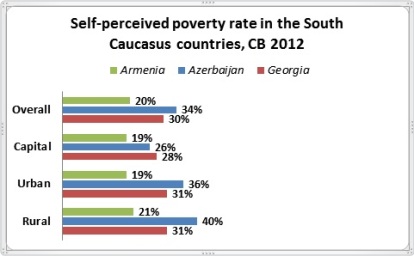Self-Perceived Poverty in the South Caucasus Countries
Self-Perceived Poverty in the South Caucasus Countries
by Anna Drnoyan
Poverty is the condition of many nations in the world. It has been and remains to be one of the widespread challenges for many countries. International organizations and individual researchers have been focused on the development of quantifiable definitions of poverty. The current international experience has relied on absolute (threshold), relative (based on the place and time you live in), self-perceived (indicated by the respondent), consensual (in accordance with the publicly agreed minimum standard), deprivation (exclusion from the ordinary pattern in society) and other approaches to measure poverty (Mack 2011). This entry explores self-reported poverty in the South Caucasus. To compare Armenia, Azerbaijan and Georgia, data from the Caucasus Barometer 2012[1] dataset (CB) is used. CB is a yearly nationwide representative survey conducted in the three republics of the South Caucasus, covering a wide range of issues, including self-reported economic well-being[2].
The CB question used in this analysis is formulated as follows: “Relative to most of the households around you, would you describe the current economic condition of your household as very poor, poor, fair, good or very good.” So how does self-reported poverty look like in the three South Caucasus republics? Is there a difference between the three countries? And is there a difference between people of the capital cities, other towns and the rural population? Firstly, let us have a look at the descriptive statistics. For the purpose of simplicity, we have combined “very poor” and “poor” response categories. The graph below presents the newly created category of the self-reported poverty as reported by residents of rural, urban and capital settlements of the three South Caucasus republics.

Self-perceived poverty rate in the South Caucasus countries, Caucasus Barometer, 2012
As the graph shows, 20% of Armenians perceive themselves to be poor, while in Azerbaijan and Georgia these numbers are higher, 34% and 30% respectively. When comparing settlements, capital cities of all three countries fare the best, which is not surprising. Self-reported poverty is highest in rural areas in all the three South Caucasus countries, though it is only slightly higher than in urban areas. Now let us turn to statistical analysis[3] and check whether our findings are statistically significant – the term coined by researchers to demonstrate that their discovery occurred not only by chance, but is predicted with certain likelihood. So, the statistics indicate that the self-reported poverty levels are significantly different between the three South Caucasus countries. In particular, Armenia’s records are significantly different from that of both Azerbaijan and Georgia, while the latter countries do not account to significance among each other. Significance is also revealed between the settlement types of the region, specifically capital cities are significantly distinct from other urban and rural areas. Moreover, Azerbaijan is the only country between the three targeted ones to exhibit the statistical significance within its settlements, notably, Baku contrasts to other Azerbaijani cities and rural locations.
However, some limitations of denouncing poverty based only on the self-reported characteristics should be indicated here, as they might have directly affected the findings. Particularly in the cases we discussed above, people may report themselves to be in fair conditions if their neighbors and relatives are even worse off. In other words, though a respondent is still under the poverty line in absolute terms but s/he believes that everything is not so bad when compared to others. This logic can explain why Armenia recorded the lowest levels of self-perceived poverty despite of not demonstrating the highest macroeconomic indicators in the South Caucasus.
In conclusion, the findings suggest that apart from capital cities, other settlements of the three South Caucasus countries are vulnerable to high levels of poverty as recorded by the respondents themselves. Meanwhile, we also propose to account for above indicated limitations, and base the further track of poverty trends on both objective and subjective indicators. That will help to derive more evidence-based policies for poverty eradication [1]. The analysis of the previous years’ datasets (2009-2011) produced similar results; therefore we decided to concentrate only on the most present-day available data [2]. For more information please visit http://crrc.am/research-and-surveys/caucasus-barometer?lang=en [3] One-way ANOVA test for means comparison